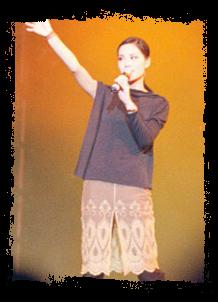
Martin Margiela is a fashion paradox. Eschewing fame, never showing himself, and not even putting a name on his clothes, this is one designer who's an icon despite himself. Holed-up in an abandoned factory on the out-skirts of Paris, he continues to shock and delight.
The J.D. Salinger of fashion, Martin Margiela has long cultivated the aura of genius. For years he has refused to be photographed. In interviews -- conducted solely by fax -- Margiela fields questions with the cryptic acumen of a Zen Buddhist. His name does not appear on his garments, but is enigmatically signified by a blank label -- the anti-label -- enframed by four visible stitches.
Margiela's collections are invariably conceived around concepts. Two seasons ago, he amused us with a flat collection: by displacing sleeves and armholes to the front, for example, clothes were reformatted to lie perfectly flat when not worn. Margiela has gone even further in experimental fashion, creating vests strung out of broken dishes and dresses sprouting bacterial mold.
Martin Margiela was born in 1959 and graduated from the Royal Academy of Fine Arts in Antwerp. He belonged to the seminal fashion cell group, the Antwerp Six, whose other members are Ann Demeulemeester, Dries Van Noten, Dirk Bikkembergs, Dirk Van Saene and Walter Von Beirendonck. In 1984, he started working with Jean-Paul Gaultier, breaking off four years later to start his own company, La Maison Martin Margiela.
Though many designers might have been content to coast on the strength of such glittering associations, Margiela took a riskier route, with off-beat clothes -- though usually wearable and saleable -- and strange fashion shows verging on performance art: in vacant lots and abandoned metros; where models were replaced by didactic overhead slides, life-sized marionettes or men in lab-coats carrying the collection on hangers; or where nothing new was shown, only favorite pieces from past collections dyed in gray.
Margiela is most often pigeonholed as a deconstructionist and grunge advocate. Like Rei Kawakubo of Comme des Garçons, Margiela has long used external seams, darts, shoulder pads, and bustles -- revealing, by exposing, as it were, the very tools of the trade. By tweaking the shoulders of his popular cigarette coat, Margiela was able to achieve a very narrowly cut coat. His spring/summer '97 collection, which used sewing dummies' markings and fabrics, is, to date, the most blatant example of Margiela's obsession with technique and construction.
Margiela earned the grunge label by mixing flea market finds with "original" clothes. Emblematic of this was his sweater made out of army socks and reworked '50s ballgowns worn over jeans. In 1993, he showed reconstructed theatre costumes. His 1996 photoprint collection, where photos of garments like fur coats and thick woollen men's sweaters from the '30s were transferred onto light crepe fabrics, added a new twist to the emperor's new clothes conundrum.
Given Margiela's iconoclastic tendencies, his appointment in April 1997 as head of Hermès' women's ready-to-wear line shocked the fashion world. But the creative merger is not as outlandish as it first seemed as the designer and the house share a passion for craftsmanship.
Margiela's first effort for Hermès, shown in March 1998, toed the company line, combining luxurious materials like camel and deerskin and the artisanal techniques of hand-rolled seams. Though too conventional for Margiela purists, the comfortably mannish collection proved that the Belgian could harness his avant-garde preferences when he wanted and that when it came to designing for Hermès' equestrian tastes, Margiela was not such a dark horse choice after all. - Clara Young